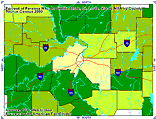 |
|||||||||
|
| home | our mission | contact us | issue archive |

Jul 2002 / from the editor :: email this story to a friend

Statistically Significant
By Brian H. MarstonThe U.S. Census Bureau's mission is "To be the preeminent collector and provider of timely, relevant, and quality data about the people and economy of the United States." The statistics that the Census Bureau compiles are used by the government and businesses as a basis for planning. They also paint a clear picture of some of the ugly truths that most people would rather not see. Recently released numbers from the 2000 census are no exception.
For example, some people, especially those with a Y chromosome, like to believe that we live in a glorious time of gender equality in the workplace. The census says otherwise. In the city of St. Louis in 1999, the median earnings for male full-time, year-round workers were $30,106. Females earned $24,987, 17% less.
Not surprisingly, wealth is not distributed equally throughout our region. What is surprising is just how lopsided the distribution is. According to the Census Bureau, the median household income for the eight-county region in 1999 was $45,090. For the city of St. Louis it was $27,156. Per capita income was $27,595 for St. Louis County, $22,882 for the region and $16,108 for the city. Stop for a moment and ponder that disparity.
At the lowest end of the income scale, individuals who lived alone in 1999 were considered to be below the poverty level if their annual income was less than $8,501. The poverty level for a family of four was $17,029. In 1999, 24.6% of city residents (nearly one in four) lived in poverty. The poverty rate for the eight-county region as a whole was 10.3%.
St. Louisans are segregated not just economically, but racially as well. Brace yourself and consider these facts: The city of St. Louis is 43.8% white, St. Louis County is 76.8% white and diversity-challenged St. Charles County is 94.7% white. The, um, non-random distribution of melanin across our metro area makes it clear why the mass exodus to the suburbs is sometimes referred to as white flight.
click to enlarge To be fair, people of all colors have been moving out of the city. During the 90s, the city lost 12.2% of its population, a period when exurban St. Charles County grew 33.3%. Even as someone who could live anywhere and chooses to live in the city, it's hard to believe the claims that the city is back. By some measures, it is showing signs of recovery. For example, according to the St. Louis Association of Realtors, the median single-family home price in the city is up 12.8% from last year. But there's still a lot that needs to happen before the city will be able to pull itself out of the hole it's in. As the Rams say, gotta go to work.
To me, one of the most shocking figures buried in the Census Bureau's tables is that 28.7% of the people over 25 in the city never graduated from high school. 9.6% never made it to 9th grade. Things are a little better over in St. Louis County, where 12% of the people over 25 don't have high school diplomas. The national high school graduation rate is only 80.4%, which has grave implications for a country with an information age economy and a democratic government.
The Census Bureau doesn't offer any solutions for addressing the problems its statisticians track. Still, it provides an incredibly valuable service. After all, the first step of any 12-step program is to admit you have a problem. Cold, hard numbers have a sobering effect on denial.
Brian Marston has a degree in math and used to work at the Office of Social and Economic Data Analysis.
Church and State | Games | Expatriates | Communities | From the Source
It's All Happening | Young Minds | The Ordinary Eye | Elsewhere
Sights and Sounds | Media Shoegaze | A Day's Work | From the Editor© 2002 The Commonspace
